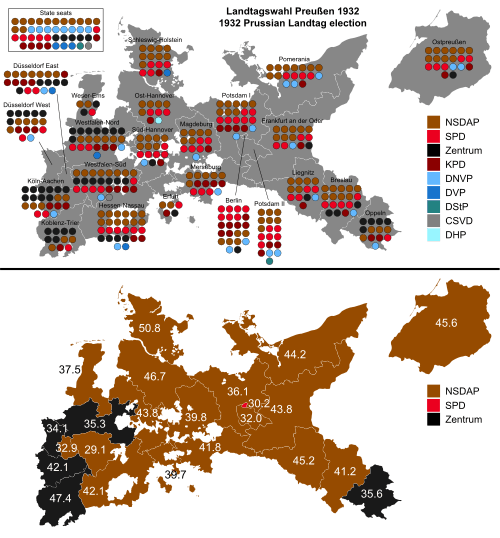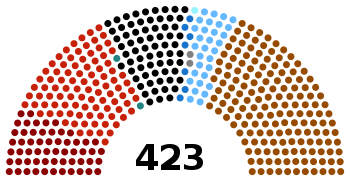1932 Prussian state election
State elections were held in the Free State of Prussia on 24 April 1932 to elect all 423 members of the Landtag of Prussia.[1] The election saw the Nazi Party become the largest party in Prussia, winning 36% of the vote. The coalition of the Social Democratic Party, Centre Party, and German Democratic Party (now the German State Party), which had governed Prussia since 1919, lost its majority. The SPD, DNVP, and DVP all suffered huge losses. The Wirtschaftspartei lost all its seats, while the DVP and DStP were left with only a handful each. The Centre Party stayed steady, and the Communist Party made minor gains.
| |||||||||||||||||||||||||||||||||||||||||||||||||||||||||||||||||||||||||||||||||||||||||||||||||||||||||
All 423 seats in the Landtag of Prussia 212 seats needed for a majority | |||||||||||||||||||||||||||||||||||||||||||||||||||||||||||||||||||||||||||||||||||||||||||||||||||||||||
|---|---|---|---|---|---|---|---|---|---|---|---|---|---|---|---|---|---|---|---|---|---|---|---|---|---|---|---|---|---|---|---|---|---|---|---|---|---|---|---|---|---|---|---|---|---|---|---|---|---|---|---|---|---|---|---|---|---|---|---|---|---|---|---|---|---|---|---|---|---|---|---|---|---|---|---|---|---|---|---|---|---|---|---|---|---|---|---|---|---|---|---|---|---|---|---|---|---|---|---|---|---|---|---|---|---|
| Turnout | 22,065,427 (82.10%) | ||||||||||||||||||||||||||||||||||||||||||||||||||||||||||||||||||||||||||||||||||||||||||||||||||||||||
| |||||||||||||||||||||||||||||||||||||||||||||||||||||||||||||||||||||||||||||||||||||||||||||||||||||||||
 Top: results by constituency. Bottom: winning party in each constituency. | |||||||||||||||||||||||||||||||||||||||||||||||||||||||||||||||||||||||||||||||||||||||||||||||||||||||||
| |||||||||||||||||||||||||||||||||||||||||||||||||||||||||||||||||||||||||||||||||||||||||||||||||||||||||
The resulting Landtag was divided between the SPD–Zentrum–DStP coalition, the Nazi–DNVP bloc, and the Communist Party. Prussia used the constructive vote of no confidence, meaning a government could be removed from office only if there was a positive majority for a prospective successor. No parliamentary force held a majority, but since none were willing to cooperate with any of the others, the SPD-led coalition could not be removed. It continued in office as a minority government.
This situation ended on 20 July 1932 with the Preußenschlag, in which Reich President Paul von Hindenburg, on the advice of Reich Chancellor Franz von Papen, issued an emergency decree under Article 48 of the Weimar Constitution, which dissolved the Prussian government and gave von Papen direct control over Prussia as Reichskommissar.[2] Prussia remained under direct control of the federal government until April 1933 when, at the behest of Adolf Hitler under the Enabling Act of 1933, state elections were held in Prussia. The Nazis failed to win a majority, but later gained one after the banning of the Communist Party and the arrest of opposition deputies. The federal structure of Germany was effectively dissolved under the Nazi regime, and the Prussian government existed only symbolically. After the conclusion of the Second World War, Prussia was dissolved by a declaration of the Allied Control Council on 25 February 1947.
Results
 | ||||||
| Party | Votes | % | Swing | Seats | +/– | |
|---|---|---|---|---|---|---|
| National Socialist German Workers Party (NSDAP) National Socialist German Workers Party (NSDAP) Farmers, Home and Landowners Nationalist German Workers Party Greater German List Schmalix |
8,091,072 8,007,384 67,533 11,605 4,550 |
36.67 36.29 0.31 0.05 0.02 |
+34.60 +34.45 +0.15 New New |
162 162 0 0 0 |
+156 +156 0 New New | |
| Social Democratic Party (SPD) | 4,675,173 | 21.19 | –7.81 | 94 | –43 | |
| Prussian Centre Party (Zentrum) | 3,371,932 | 15.28 | +0.05 | 67 | –4 | |
| Communist Party of Germany (KPD) Communist Party of Germany (KPD) Interest Group of Small Pensioners and Inflation Victims |
2,845,306 2,819,763 25,543 |
12.89 12.78 0.12 |
+1.02 +0.91 New |
57 57 0 |
+1 +1 New | |
| German National People's Party (DNVP) German National People's Party (DNVP) Radical Middle Class National Gathering Karl Andres |
1,540,716 1,524,230 9,883 6,603 |
6.98 6.91 0.04 0.03 |
–10.41 –10.48 New New |
31 31 0 0 |
–51 –51 New New | |
| German People's Party (DVP) German People's Party (DVP) People's Justice Party (VRP) |
374,509 330,745 43,764 |
1.70 1.50 0.20 |
–8.05 –7.00 –1.05 |
7 7 0 |
–35 –33 –2 | |
| National Front of German Estates Reich Party of the German Middle Class (WP) German Farmers (Christian-National Peasants' and Farmers' Party) National Front of German Estates, Young Rights National Officials, Employees and Free Professionals |
362,272 191,021 153,542 13,861 3,848 |
1.64 0.87 0.70 0.06 0.02 |
–4.28 –3.59 –0.77 New New |
0 0 0 0 0 |
–29 –21 –8 New New | |
| German State Party (DStP) | 332,490 | 1.51 | –2.95 | 2 | –19 | |
| Christian Social People's Service (CSVD) | 255,177 | 1.16 | New | 2 | New | |
| Socialist Workers' Party of Germany (SAPD) | 80,392 | 0.36 | New | 0 | New | |
| German-Hanoverian Party (DHP) | 63,731 | 0.29 | –0.70 | 1 | –3 | |
| National Minorities of Germany (NMD) Polish People's Party Schleswig and Frisian Home Prussian-Lithuanian People's Party |
59,943 57,285 2,298 360 |
0.27 0.26 0.01 0.00 |
–0.13 –0.12 0.00 0.00 |
0 0 0 0 |
0 0 0 0 | |
| National Opposition of United Reichsbank Creditors and Mark Victims National Opposition of United Reichsbank Creditors and Mark Victims People's Justice and Economic Party of the Dispossessed Middle Class German Combat Party Against Inflation and False Monetary Policy Activist Emergency Community of Mortgagees, etc. |
6,896 5,197 1,151 312 236 |
0.03 0.02 0.01 0.00 0.00 |
New New New New New |
0 0 0 0 0 |
New New New New New | |
| Party of the Unemployed for Work and Bread | 3,463 | 0.02 | New | 0 | New | |
| German Unity Party for Defence of the Economy, Idealistic Movement of Germany | 1,341 | 0.01 | New | 0 | New | |
| German National Community (Völkisch Revolutionary Economic Movement) | 1,014 | 0.00 | New | 0 | New | |
| Invalid/blank votes | 127,560 | 0.57 | – | – | – | |
| Total | 22,065,427 | 100 | – | 423 | –27 | |
| Registered voters/turnout | 27,031,562 | 82.10 | +5.71 | – | – | |
| Gonschior.de | ||||||
Results by constituency
| Constituency | NSDAP | SPD | Z | KPD | DNVP | DVP | DStP | CSVD | DHP |
|---|---|---|---|---|---|---|---|---|---|
| 1. East Prussia | 45.6 | 22.2 | 7.5 | 9.1 | 9.5 | 1.5 | 1.2 | 1.8 | – |
| 2. Berlin | 24.1 | 30.2 | 3.9 | 29.4 | 6.8 | 0.5 | 2.2 | 0.5 | – |
| 3. Potsdam II | 32.0 | 27.6 | 3.9 | 16.9 | 10.4 | 1.4 | 4.2 | 0.5 | – |
| 4. Potsdam I | 36.1 | 28.1 | 2.4 | 16.9 | 9.5 | 1.0 | 2.1 | 0.6 | – |
| 5. Frankfurt an der Oder | 43.8 | 25.4 | 6.2 | 7.3 | 10.3 | 1.3 | 1.4 | 0.8 | – |
| 6. Pomerania | 44.2 | 23.6 | 1.2 | 7.7 | 17.2 | 1.2 | 1.6 | 0.8 | – |
| 7. Breslau | 41.2 | 25.0 | 15.3 | 6.8 | 6.2 | – | 1.0 | 1.5 | – |
| 8. Liegnitz | 45.2 | 27.6 | 7.0 | 5.9 | 6.8 | – | 2.1 | 1.5 | – |
| 9. Oppeln | 30.4 | 7.5 | 35.6 | 12.2 | 7.5 | – | 0.5 | 0.4 | – |
| 10. Magdeburg | 39.8 | 33.8 | 2.0 | 9.3 | 8.3 | 1.9 | 1.8 | 0.4 | – |
| 11. Merseburg | 41.8 | 18.9 | 1.4 | 21.9 | 7.9 | 2.0 | 1.6 | 0.5 | – |
| 12. Erfurt | 39.7 | 18.2 | 13.1 | 14.7 | 6.9 | 2.0 | 1.8 | 0.5 | – |
| 13. Schleswig-Holstein | 50.8 | 27.5 | 0.9 | 8.8 | 5.3 | 2.3 | 2.0 | 0.9 | – |
| 14. Weser-Ems | 37.5 | 17.6 | 25.3 | 4.7 | 5.2 | 1.8 | 1.5 | 2.1 | 2.4 |
| 15. Hanover East | 46.7 | 25.1 | 1.3 | 6.6 | 7.9 | 1.8 | 1.7 | 0.9 | 5.7 |
| 16. Hanover South | 43.8 | 31.8 | 5.8 | 5.6 | 4.6 | 2.3 | 1.5 | 0.7 | 2.1 |
| 17. Westphalia North | 25.3 | 15.5 | 35.3 | 10.5 | 5.0 | 1.9 | 0.5 | 2.0 | – |
| 18. Westphalia South | 29.1 | 17.6 | 24.3 | 16.2 | 4.5 | 1.6 | 1.0 | 3.0 | – |
| 19. Hesse-Nassau | 42.1 | 21.5 | 14.4 | 9.5 | 3.4 | 2.4 | 1.8 | 2.0 | – |
| 20. Köln-Aachen | 22.5 | 11.0 | 42.1 | 13.6 | 3.3 | 2.5 | 1.2 | 0.5 | – |
| 21. Koblenz-Trier | 28.2 | 6.3 | 47.4 | 6.7 | 4.1 | 1.5 | 0.5 | – | – |
| 22. Düsseldorf East | 32.9 | 11.8 | 20.8 | 22.7 | 4.2 | 1.9 | 0.8 | 1.7 | – |
| 23. Düsseldorf West | 29.6 | 9.5 | 34.1 | 14.8 | 5.6 | 1.6 | 0.5 | 1.0 | – |
Notes
- Combined results for the DVP and National Justice Party, which ran independently in 1928 but on affiliated lists in 1932.
References
- Dieter Nohlen & Philip Stöver (2010) Elections in Europe: A data handbook, p762 ISBN 978-3-8329-5609-7
- Walter, Franz (2007-07-19), "Putsch am 20. Juli 1932: Wie der Mythos Preußen zerschlagen wurde" [The coup of 20 July 1932: How the myth of Prussia was smashed], Der Spiegel (in German), Hamburg, retrieved 4 May 2013:
- Ein Tag als Lehrstück: für die antidemokratische Skrupellosigkeit der Konservativen jener Jahre, für die Hilflosigkeit und Ermattung der stets nur rhetorisch kraftvoll auftretenden Sozialdemokratie, für die Erosion und den Zerfall der republiktreuen Mitte - schon Monate vor der Etablierung des NS-Regimes. [One day as an object lesson: in the antidemocratic unscrupulousness of the conservatives of those years, in the helplessness and fatigue of the Social Democrats, who only rhetorically ever seemed powerful, in the erosion and breakup of the republican center — months before the establishment of the Nazi regime.]